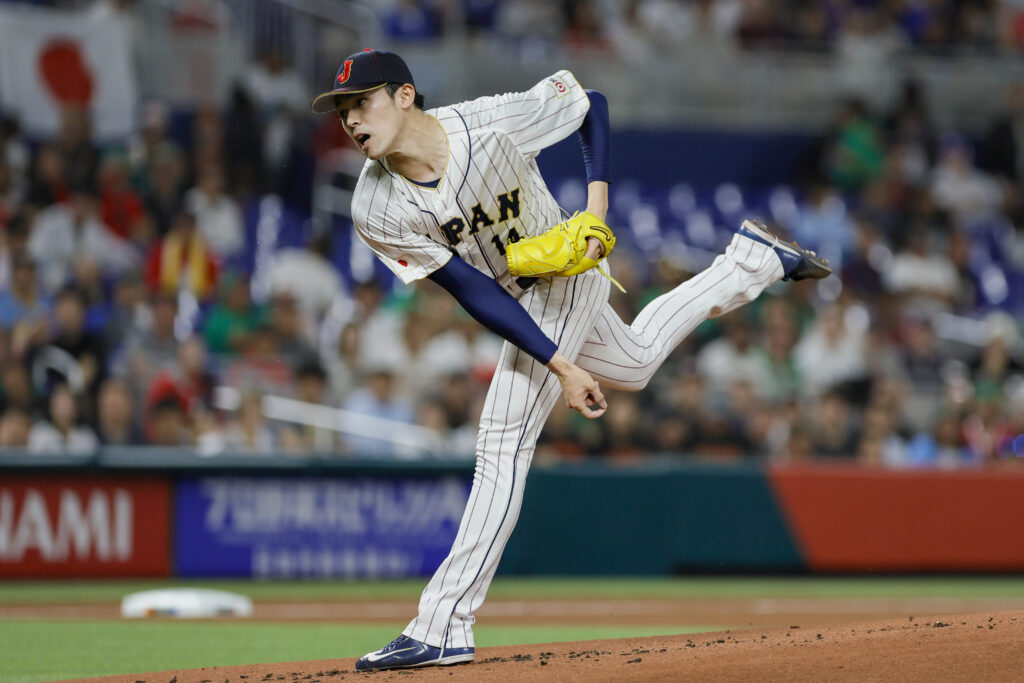Roki Sasaki is in line to come to MLB next season. His NPB team, the Chiba Lotte Marines, announced overnight (on X) that they intend to make the star right-hander available to major league clubs via the posting system. The Marines didn’t reveal a specific date for when they’ll open the posting window. ESPN’s Jeff Passan writes that that has not been decided. Whenever Sasaki is officially posted, he’ll have a 45-day period to field interest and decide where he wants to sign.
The announcement opens one of the top storylines of the offseason. Sasaki, who turned 23 last week, is the best pitcher in Japan. He’s one of the most talented pitchers on the planet. It’s the second consecutive offseason in which MLB teams will compete for arguably NPB’s best pitcher. Unlike the Yoshinobu Yamamoto bidding, Sasaki’s earning power is capped at a few million dollars.
MLB classifies players who sign out of a foreign league before they turn 25 as amateurs. Those players can only sign a minor league contract and are subject to a hard-capped bonus limit. Whichever team signs Sasaki is allowed to add him to the MLB roster by Opening Day — he isn’t going to start the season in Triple-A even though his first contract will be a minor league deal — but he won’t be able to sign for more than a few million dollars.
After he signs, Sasaki will be subject to the same six-year control window that applies to any player called up from the farm system. He’ll play the next three seasons on roughly league minimum salaries before going through arbitration three times thereafter. Sasaki would not return to the open market until the 2030-31 offseason. He would be eligible to sign an extension during his team control window, but MLB has the ability to block a contract it deems a circumvention of the bonus pool limits. There’s no set criteria for what might cause MLB to intervene, but it’s safe to say that Sasaki won’t be signing a massive extension within a few weeks of agreeing to a modest signing bonus.
Yamamoto waited until his 25th birthday to avoid the bonus pool limit. That freed him to sign with the Dodgers for $325MM, the largest guarantee for a pitcher in history. Sasaki didn’t want to follow that path. He instead prioritized making the move to MLB as quickly as possible, though that required the participation of the Marines.
NPB players are not eligible for international free agency until they’ve accrued nine years of service time. Sasaki has pitched at Japan’s highest level for four years. He unsuccessfully pushed for the Marines to post him for MLB teams last offseason. He gets his wish this time around. There’s been speculation that Sasaki’s contract might’ve contained some kind of clause to force the team’s hand.
Whether out of contractual obligation or simply to honor the player’s wishes, the Marines will lose their ace for essentially nothing. The posting agreement between MLB and Nippon Professional Baseball ties the NPB team’s compensation to the value of the free agent contract. An MLB team signing a posted player pays a fee to the Japanese team on top of what goes to the player. The fee is a fixed amount calculated as 20% of a deal’s first $25MM, 17.5% of the next $25MM, and 15% of further spending.
Yamamoto’s $325MM deal came with a windfall for his former team, the Orix Buffaloes. The Dodgers paid the Buffaloes $50.625MM to release him from his contract. The Marines will get a fraction of that. If Sasaki signs for $10MM — and there’s a decent chance his bonus will land below that — the team would receive a $2MM posting fee.
The Marines’ loss will be an MLB team’s gain. Evaluators project Sasaki as a top-of-the-rotation starter. The 6’2″ righty can push into the triple digits with his fastball and has a potentially lethal splitter. He did lose a bit of life this past season, though the pitch still sits in the upper 90s. Marquee’s Lance Brozdowski reports (YouTube link) that Sasaki averaged 97.1 MPH with his fastball this year after sitting at 99 MPH in ’23. That’s well above average for an MLB starter despite trending in the wrong direction.
While the fastball velocity is eye-catching, evaluators suggest his low-90s splitter is his best pitch. He deploys a slider as his top breaking ball, and while that’s not as well regarded as the fastball-splitter combination, it’s regarded as a potential above-average offering. Writing for Baseball America in 2023, Kyle Glaser projected Sasaki as an ace who’d warrant the first overall pick if he were in the domestic amateur draft. Glaser ranked Sasaki as the most talented non-MLB player in the ’23 World Baseball Classic, one spot ahead of Yamamoto. Sasaki struck out 11 hitters over 7 2/3 innings of four-run ball for Japan’s championship team in that tournament.
The 6’2″ hurler has posted dominant numbers on a rate basis in NPB. He has a career 2.10 earned run average in nearly 400 innings at Japan’s top level. This year’s 2.35 ERA was the highest of any of his four seasons. In a relative down year, Sasaki punched out nearly 29% of batters faced against a manageable 7.1% walk percentage.
To the extent there’s a knock against Sasaki, it’s his workload. He has yet to reach 130 innings in any season. He was limited to 111 frames this year and missed time midseason due to an unspecified injury in his throwing arm. That’s a concern when paired with his slight velocity dip, but it’s unlikely to dissuade teams from an all-out recruitment. The upside of getting a potential top-of-the-rotation arm far outweighs the minimal cost for a signing team.
More to come.

